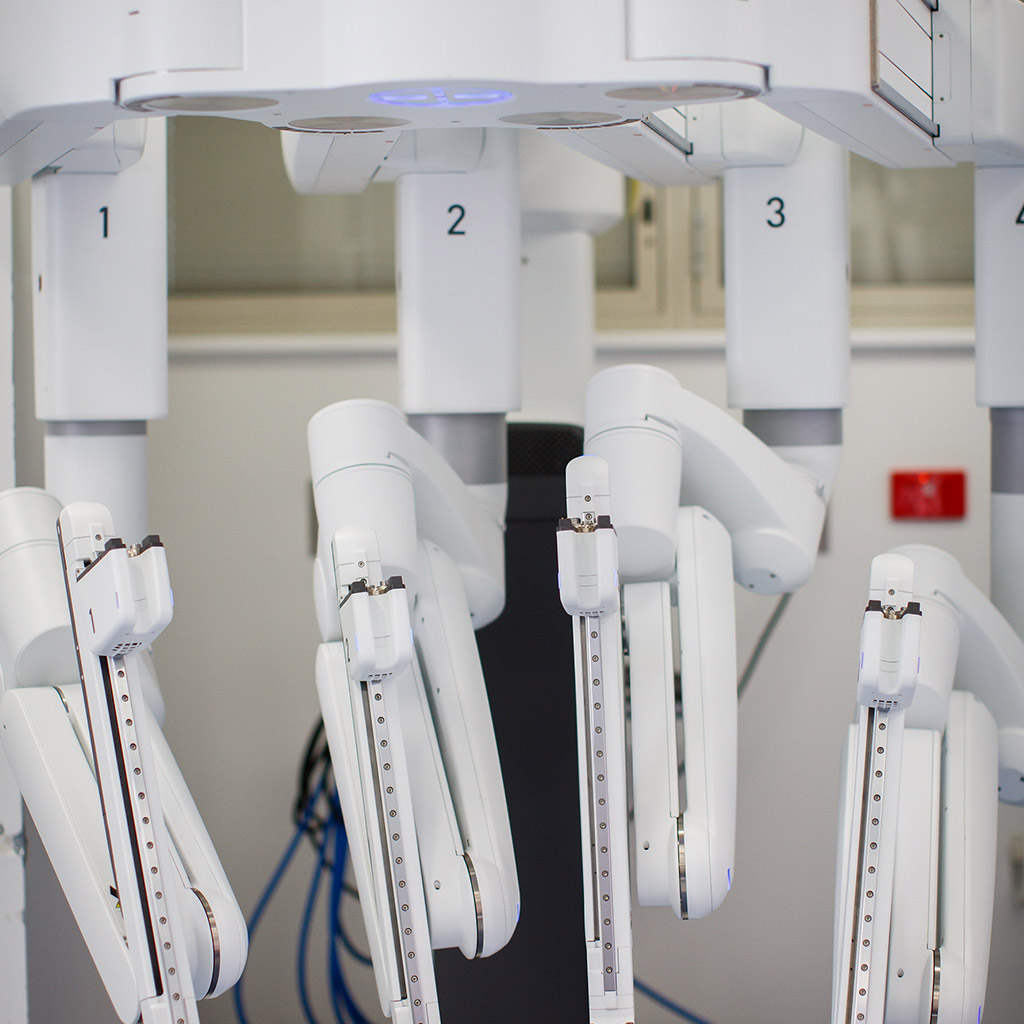Robot Assisted Radical Prostatectomy
The Procedure
In a laparoscopic radical prostatectomy, the surgeon puts a narrow telescope (called a laparoscope) and tiny instruments through small incisions into the abdomen. The surgeon then removes the whole prostate gland, seminal vesicles and the draining lymph nodes for cancer of the prostate. The vas deferens are connected to the prostate and are tied with the procedure.
Normally, a full general anaesthetic will be used and you will be asleep throughout the procedure. In some patients, the anaesthetist may also use an epidural or spinal anaesthetic which improves or minimises pain post-operatively.
One small incision is made in the umbilicus (belly-button) with two other incisions, one on either side. A further incision may be made in the right-hand lower part of the abdomen.

The special da Vinci instruments, including a stereoscopic camera, are inserted into the abdomen to allow the operation to take place.
The operation usually takes 3-4 hours to complete although there is usually an additional hour of preoperative preparation.
You will have a catheter draining urine from the bladder (which is normally removed after 1-2weeks) and an abdominal drain which is removed after 24-48 hours. You may notice some abdominal bloating and shoulder discomfort immediately after the operation. This is due to the gas which is used to fill the abdomen during the operation.
You will be given fluids to drink from an early stage after the operation and you will be encouraged to mobilse early to prevent blood clots in the veins of your legs. The average hospital stay is 2-3 days and arrangements will be made for you by your surgeon to have your catheter removed.
Most procedures have a potential for side-effects and these are outlined below.
Common (greater than 1 in 10)
- Temporary difficulties with urinary control.
- Impairment of erections due to unavoidable nerve damage (20-50% of men with good pre-operative sexual function). The risk of this happening will depend on your age, previous erections and also on whether the surgeon has decided to remove one or both nerves because the tumour was extending into them. This will have been discussed with you beforehand.
- No semen is produced during an orgasm (resulting in infertility).
Occasional (between 1 in 10 & 1 in 50)
- Scarring at the bladder exit resulting in weakening of the urinary stream and requiring further surgery (5%).
- Severe urinary incontinence (temporary or permanent) requiring pads or further surgery (2-5%).
- Blood loss requiring transfusion or repeat surgery.
- -Discovery that cancer cells have already spread outside the prostate requiring further treatments such as radiotherapy and/or hormone therapy.
- Lymph fluid collection in the pelvis if lymph node sampling is performed (less than 1 in 50).
- Anaesthetic or cardiovascular problems possibly requiring intensive care admission (including chest infection, pulmonary embolus, stroke, deep vein thrombosis, heart attack and death).
- Pain, infection or hernia at incision sites.
- Rectal injury requiring a temporary colostomy.
If you develop a temperature, increased redness, throbbing or drainage at the site of the operation, please contact your surgeon or go to your nearest hospital emergency department.
If you have problems with your catheter (especially if it falls out), contact your surgeon. If you become unable to pass urine after your catheter has been removed, you should return immediately to hospital for further treatment.
To improve urinary control, pelvic floor exercises are helpful. These can be taught before your surgery.
It will be at least 7-10 days before the pathology results on your prostate are available.
You will be followed up closely after your operation, by means of the prostate blood test (PSA). This levels should remain near zero after surgery. If the PSA rises, it indicates a return of the cancer and will require further treatment in the form of radiotherapy or drugs.
It is common to experience some loss of control over passing urine; this tends to settle within 3-6 months after surgery but, during this period, you are likely to wear absorbent pads. You are likely to find that you have difficulty achieving an erection. This will depend on whether it was possible for your surgeon to save the nerves running along the prostate.

